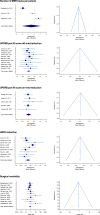Intraoperative microelectrode recording during asleep deep brain stimulation of subthalamic nucleus for Parkinson Disease. A case series with systematic review of the literature
- PMID: 39031226
- PMCID: PMC11271364
- DOI: 10.1007/s10143-024-02563-1
Intraoperative microelectrode recording during asleep deep brain stimulation of subthalamic nucleus for Parkinson Disease. A case series with systematic review of the literature
Abstract
The use of microelectrode recording (MER) during deep brain stimulation (DBS) for Parkinson Disease is controversial. Furthermore, in asleep DBS anesthesia can impair the ability to record single-cell electric activity.The purpose of this study was to describe our surgical and anesthesiologic protocol for MER assessment during asleep subthalamic nucleus (STN) DBS and to put our findings in the context of a systematic review of the literature. Sixty-three STN electrodes were implanted in 32 patients under general anesthesia. A frameless technique using O-Arm scanning was adopted in all cases. Total intravenous anesthesia, monitored with bispectral index, was administered using a target controlled infusion of both propofol and remifentanil. A systematic review of the literature with metanalysis on MER in asleep vs awake STN DBS for Parkinson Disease was performed. In our series, MER could be reliably recorded in all cases, impacting profoundly on electrode positioning: the final position was located within 2 mm from the planned target only in 42.9% cases. Depth modification > 2 mm was necessary in 21 cases (33.3%), while in 15 cases (23.8%) a different track was used. At 1-year follow-up we observed a significant reduction in LEDD, UPDRS Part III score off-medications, and UPDRS Part III score on medications, as compared to baseline. The systematic review of the literature yielded 23 papers; adding the cases here reported, overall 1258 asleep DBS cases using MER are described. This technique was safe and effective: metanalysis showed similar, if not better, outcome of asleep vs awake patients operated using MER. MER are a useful and reliable tool during asleep STN DBS, leading to a fine tuning of electrode position in the majority of cases. Collaboration between neurosurgeon, neurophysiologist and neuroanesthesiologist is crucial, since slight modifications of sedation level can impact profoundly on MER reliability.
Keywords: Asleep; Deep brain stimulation; Microelectrode recording; Parkinson disease.
© 2024. The Author(s).
Conflict of interest statement
The authors declare no competing interests.
Figures



References
-
- Asha MJ, Fisher B, Kausar J, Garratt H, Krovvidi H, Shirley C, White A, Chelvarajah R, Ughratdar I, Hodson JA, Pall H, Mitchell RD (2018) Subthalamic deep brain stimulation under general anesthesia and neurophysiological guidance while on dopaminergic medication: comparative cohort study. Acta Neurochir (Wien) 160:823–829. 10.1007/s00701-018-3473-4 - PMC - PubMed
-
- Benazzouz A, Breit S, Koudsie A, Pollak P, Krack P, Benabid A-L (2002) Intraoperative microrecordings of the subthalamic nucleus in Parkinson’s disease. Mov Disord Off J Mov Disord Soc 17(Suppl 3):S145-149. 10.1002/mds.10156 - PubMed
-
- Blasberg F, Wojtecki L, Elben S, Slotty PJ, Vesper J, Schnitzler A, Groiss SJ (2018) Comparison of awake vs. asleep surgery for Subthalamic deep brain stimulation in Parkinson’s Disease. Neuromodulation J Int Neuromodulation Soc 21:541–547. 10.1111/ner.12766 - PubMed
-
- Chen S-Y, Tsai S-T, Lin S-H, Chen T-Y, Hung H-Y, Lee C-W, Wang W-H, Chen S-P, Lin S-Z (2011) Subthalamic deep brain stimulation in Parkinson’s disease under different anesthetic modalities: a comparative cohort study. Stereotact Funct Neurosurg 89:372–380. 10.1159/000332058 - PubMed
-
- Chen Y-C, Chen S-Y, Chen T-Y, Pan J-I, Tsai S-T (2021) Desflurane and sevoflurane differentially affect activity of the subthalamic nucleus in Parkinson’s disease. Br J Anaesth 126:477–485. 10.1016/j.bja.2020.09.041 - PubMed
Publication types
MeSH terms
LinkOut - more resources
Full Text Sources
Medical
Miscellaneous

